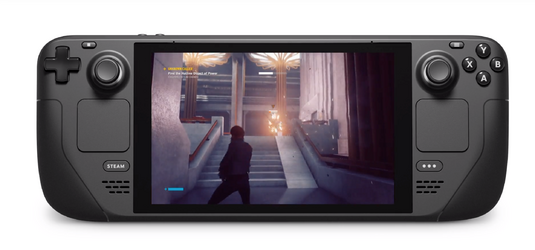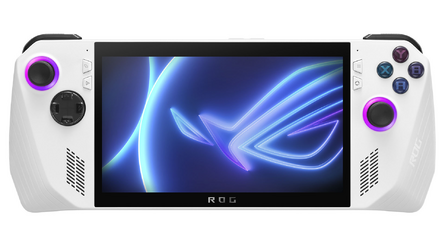Can only assume intel gave MSI a big bag of money to push this thing out.
I haven't sperged about this in this thread yet? No? Okay.
Honestly, all of the "competitors" for the Deck just reek of corporate desperation to get their slice of the cake. For years handhelds like these existed, but were nothing but a niche due to their nature. GPD Win was the main player in that market, a niche Chinese company that was hacking around to make a handheld like that using Windows.
Then Valve decided to make some new hardware that would be cool, so they looked at the Nintendo Switch, they looked at GPD Win's shit, and decided to work some magic of being a privately held company that can take risks to deliver a compelling product to the market.
The result? Steam Deck.

Now let's look at two major risks that they've taken in this product.
The biggest one: the use of Linux instead of Windows. Valve has taken major strides in bringing Windows game compatibility to Linux, dating back to their very first failed ventures into hardware that were the Steam Machines. And since they don't want to be dependent on Microsoft for their product,
and because by it's nature Windows cannot deliver a good experience in such an unusual form factor without ugly hacks, they've decided to create a dedicated Arch based distro for their machine. The end result is rather successful, so this gambit has paid off well, thanks to the level of control Valve has in this situation. It's their hardware, and it's their distro specifically for this hardware. Using Linux simply works here.
Now a less obvious one: controls. Valve wanted this to be a gaming PC, but not all PC games work well with your conventional gamepad, or they don't work at all. Plus, your typical PS/Xbox ergonomics won't exactly work well in such a device. They've decided to do something no other company did before, which is to put the analog sticks in line with the D-pad and action buttons. Not over, not under, not asymmetrically, in line. Then they added
two haptic touch pads, since PC games are mainly designed with a mouse in mind. And of course some extra buttons on the back, all wrapped together with the magic of Steam Input. That gives plenty of freedom for doing a good control scheme for PC games in this form factor. And yeah there's the gyro and the touchscreen too.
With that Valve deep throating word salad out of the way, let's look at what happened after. Investors at all the big companies got a gigantic erection after they saw the success of Valve's very unique offering and decided that the companies they have stakes in
need to make a competitor because it's an untapped goldmine, Valve is reaping all the rewards of it and they want a piece of it NOW. And they're only willing to take the risk now, because Valve took it first. Without a private company taking risks to innovate, those publicly traded conglomerates would never do shit.
And this is what they came up with:

ASUS ROG Ally

Lenovo Legion Go

MSi Claw
All three of those don't take the two major risks that Valve took.
They don't use dedicated Linux distros, because that's scary, a typical consoomer will get lost in the Linux userspace and will want familiarity, they'll want Windows. So they all run on Windows, except Windows sucks ass for this form factor. Unless Microsoft goes out of it's way to give Windows 11 a handheld mode it will be shit to use, and it'll be Windows 11, bloated and annoying, with your average consoomer not knowing how to debloat it to make it acceptable. Any handheld oriented UI and functionality is an add-in piece of software from the manufacturer, and in all three cases it's half-assed.
Now look at the control scheme. Yep, they're playing it
extremely safe, to the point of it being detrimental. ASUS ROG Ally and MSi Claw don't have a touchpad, and the Lenovo Legion Go has only one. And all three of them use the Xbox asymmetrical layout, because the average PC gamer is at most used to Xbox controllers since they work best with Windows, so let's use those, play it safe to not upset any consumers. Lenovo has that gimmick with detachable controllers, but it's just a gimmick, because they didn't bother to mirror any neat functionality that Nintendo has with their JoyCons. You just detach them and they work the same, but worse. Nothing extra beyond that.
So obviously every competitor for the Deck is designed by accountants, carefully calculated not to take any risks to keep investors happy. But you know what they
technically do better than Valve? Raw performance. Because the design by committee wasn't obvious enough, the only real redeeming qualities these devices have over the Deck is bigger number better, completely ignoring everything that made the Deck the success it is, besides the low price because of Valve's freedom to sell it at a loss in a razor and blades business model.
The MSi Claw is the most desperate out of all of them. MSi has lost a lot of face with the consumers, from Gamers Nexus' Killshot video, to their social media manager catering to furries. Intel is also unfortunately struggling badly to keep up with the competition, and instead of investing money into R&D to make a good product, they came to MSi with a deal: you make this portable device with our current CPU's that struggle with power efficiency, and our current GPU's that struggle
badly with drivers. MSi, instead of going with the safer option, went with the more riskier, but the one that got them better short term profit. A perfect representative of this brand new market.
tl;dr: every Steam Deck "competitor" is a lazy corporate cash grab and deserves to be spit upon, because if Valve didn't take the risk, they'd never be created. Publicly traded corporations stifle innovation as long as they don't have to innovate to bring profits to the investors and the entire corporate system we've created stops us from going forward as a species.
This was my TED talk, thanks for coming.





